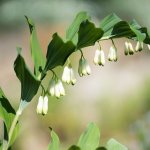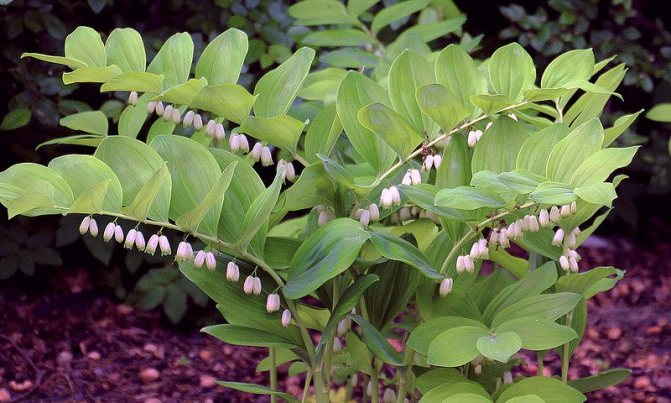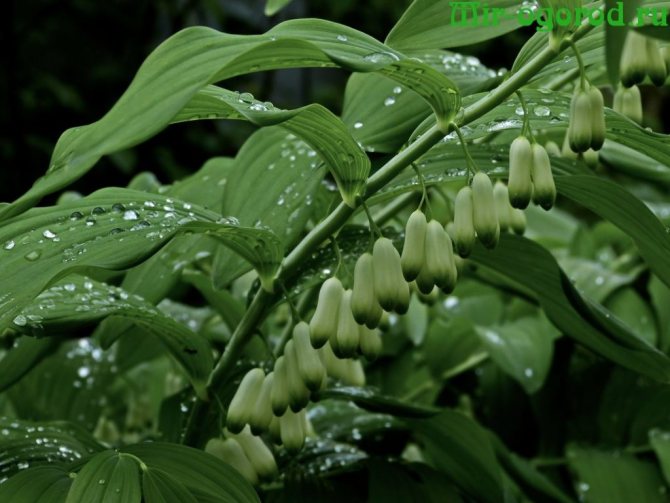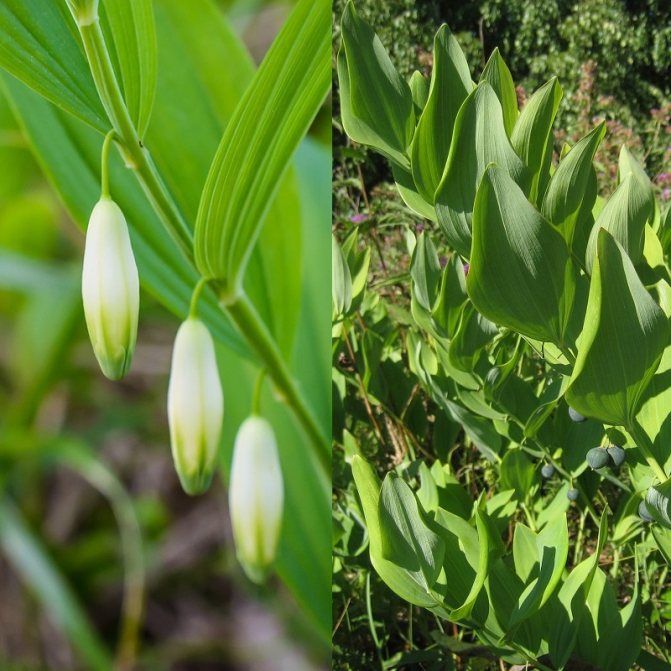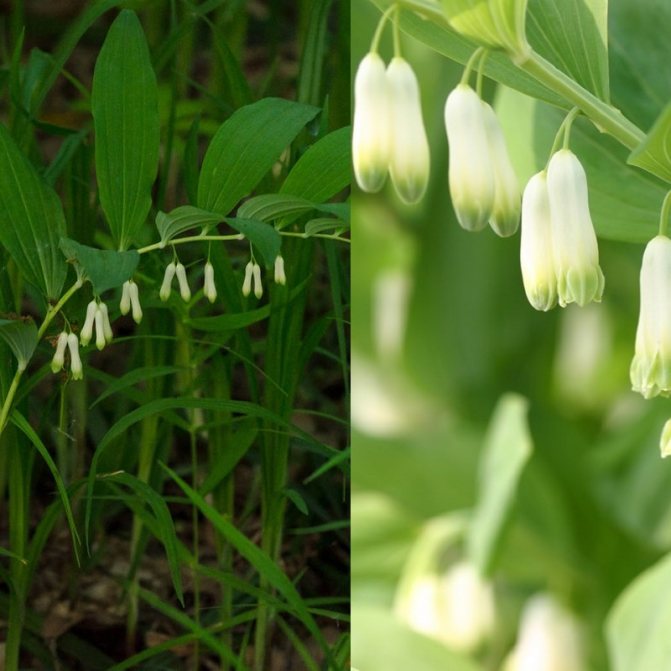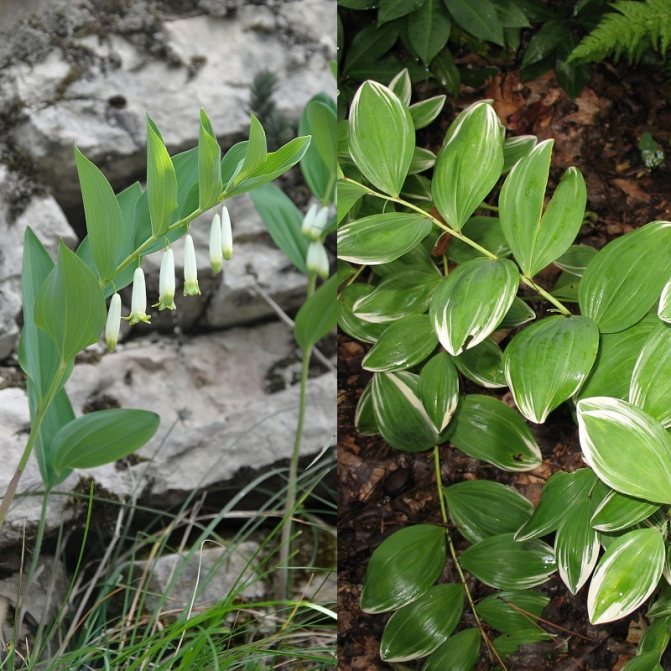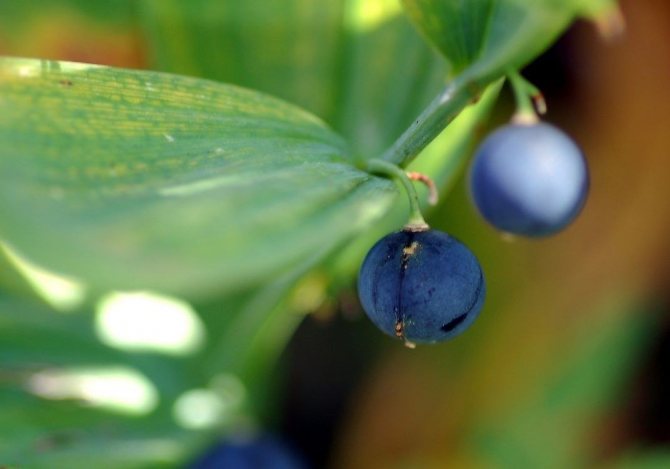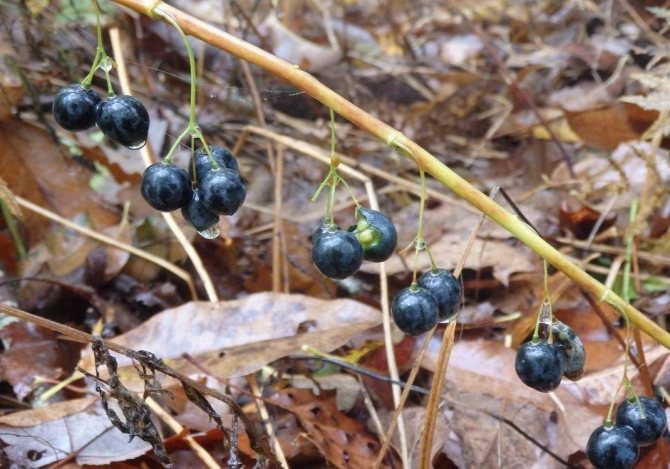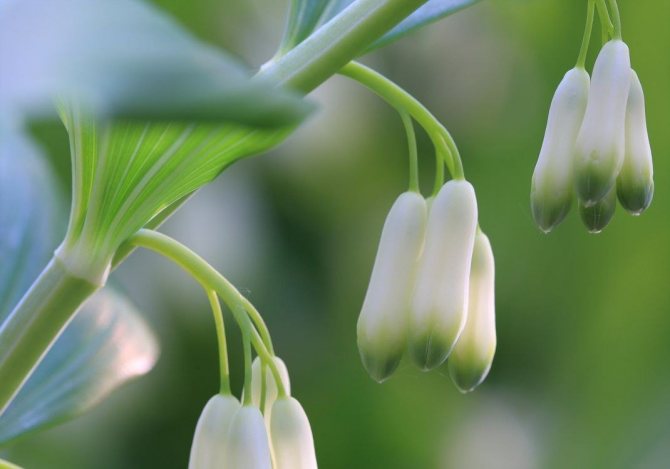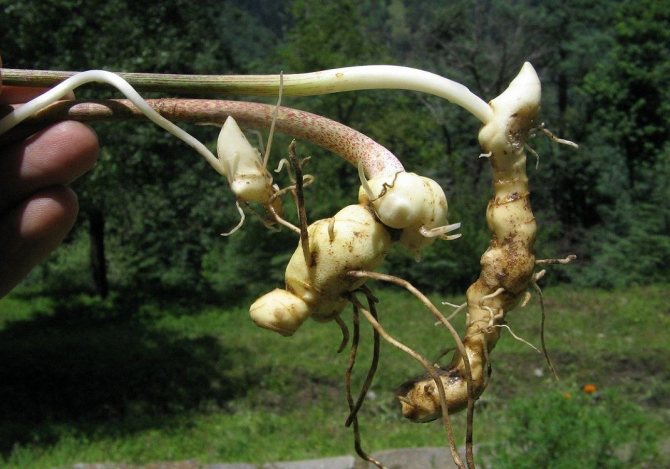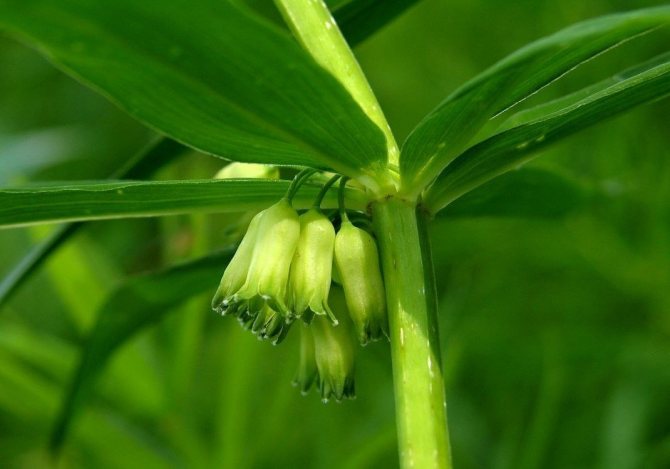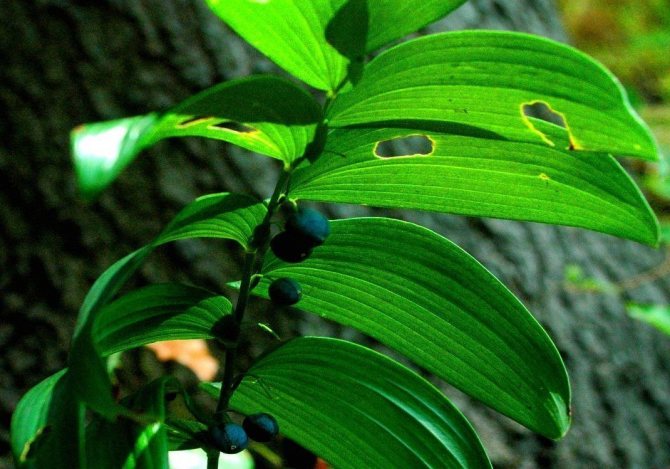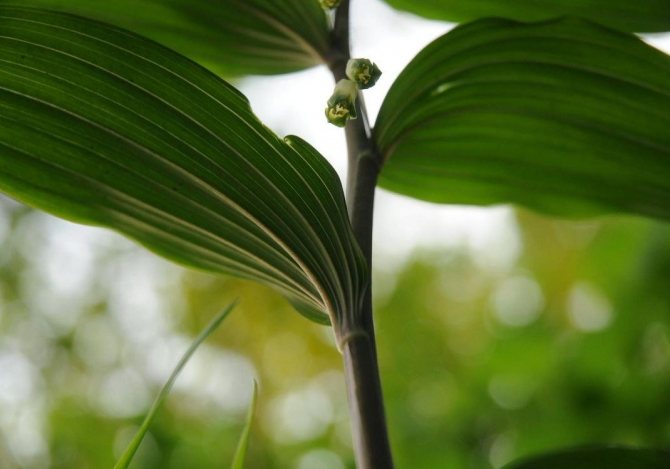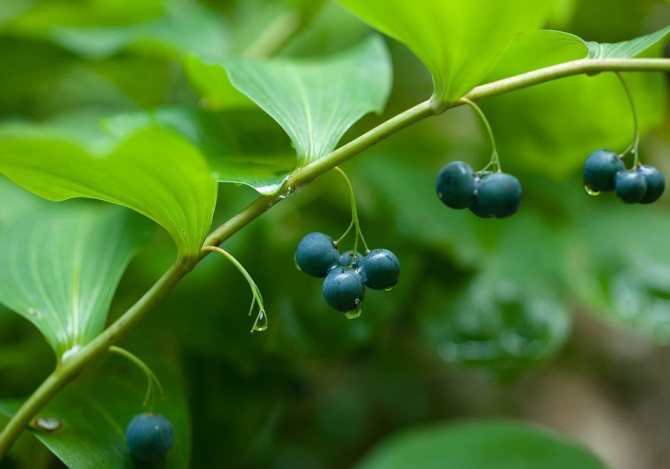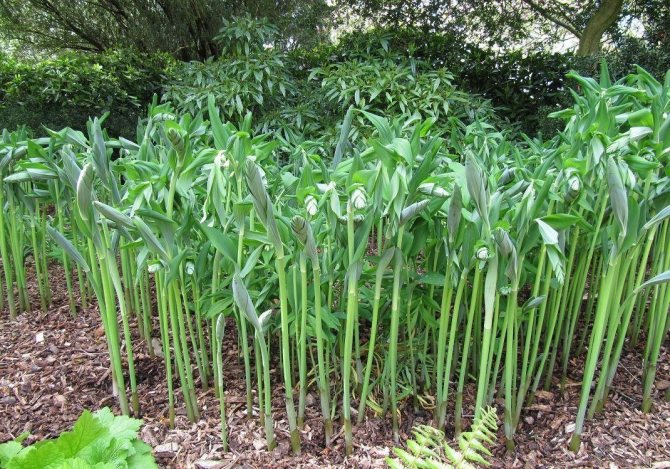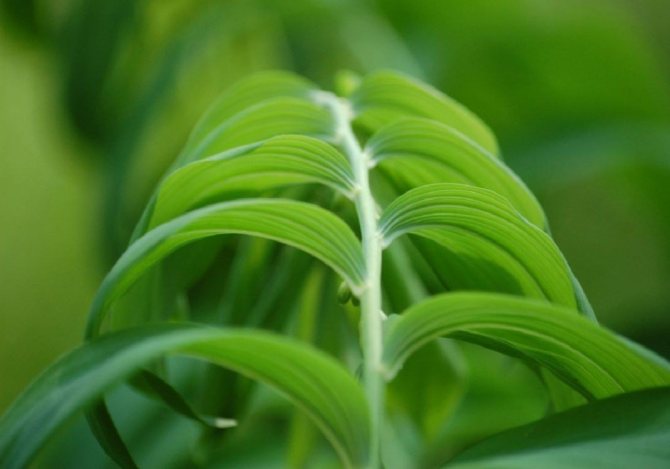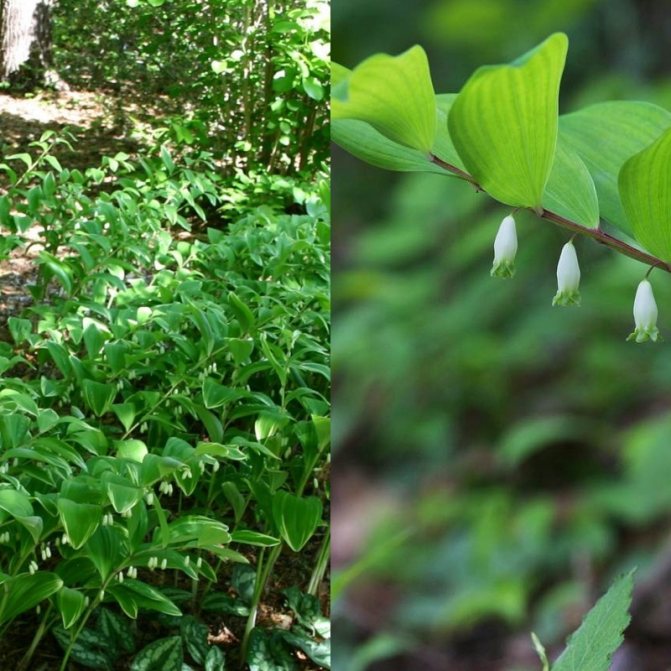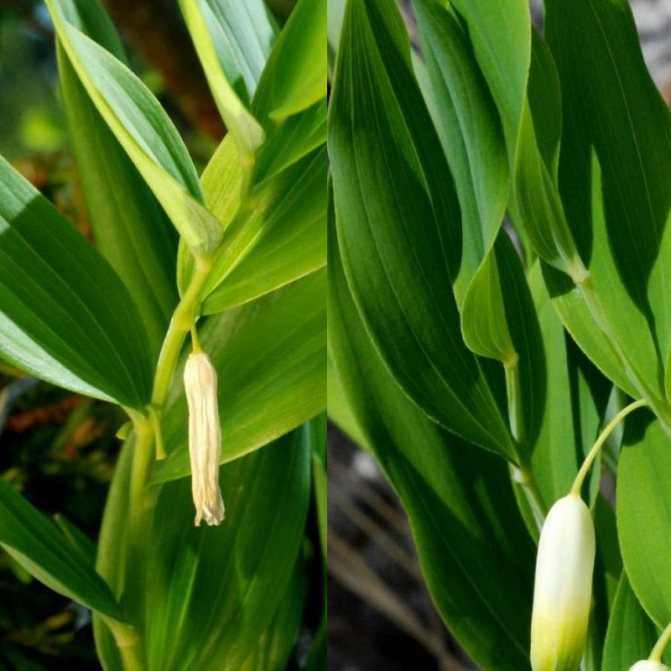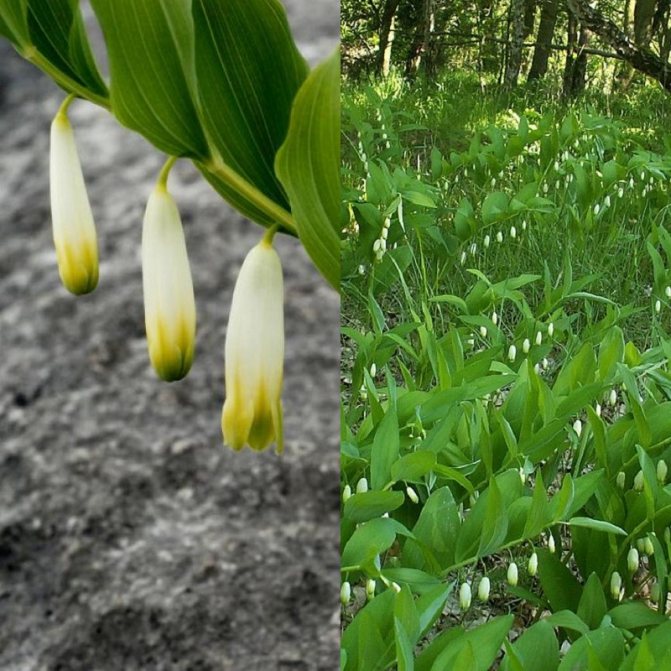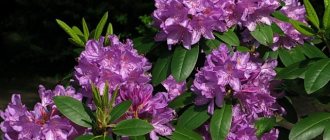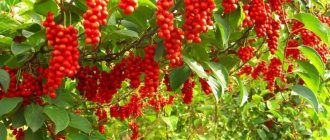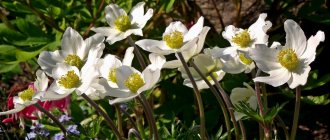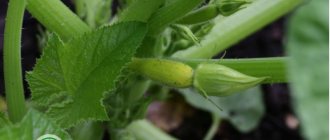Kupena is a herbaceous perennial from the Asparagus family. You can meet it on meadows and hillsides of the subtropical and temperate zones of the Northern Hemisphere. Although under the foliage, miniature flowers are hidden, similar to the usual lily of the valley, the kupena amazes with the large size of the shoots. Bright shoots take root well in the shade of trees and are indispensable for landscaping a shady area. In addition, Kupena is an effective drug. Legends say that King Solomon himself appreciated its properties and put a seal, which the roots of the plant still keep today. Therefore, the kupena is also called "Solomon's seal".
Botanical description of the kupena
Kupena (polygonatum) is a multi-species herbaceous culture that is more common in the wild on the slopes and meadows of Europe and Asia. The perennial belongs to the Liliaceae family. In addition to the fact that this unpretentious flower has excellent decorative properties, it is classified as a medicinal plant.
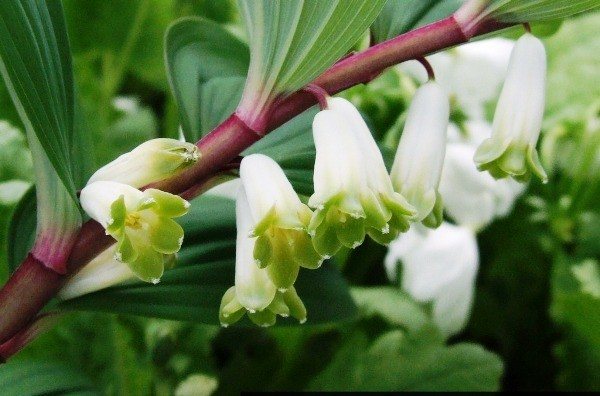
bought a photo
The plant's rhizome is located parallel to the soil surface and has many "joints" (multi-stage). Each spring, a young stem grows from the bud on the rhizome. By the onset of autumn, it dries up, retaining a print-like imprint in the place of growth. Thanks to these marks, the plant received the additional name "Solomon's seal".
The stem of the flower is ribbed, covered with a thin skin of a green tone. Some varieties have a reddish tint. Each shoot has the shape of an arc and large oblong leaves are alternately located on them.
Interesting! Depending on the growing environment, the people call the culture - garden lily of the valley, kokornik, wolf grass, core, raven berries.
In appearance it is similar to a lily of the valley. Plant height ranges from 10 cm to 1.5 m. Rhizome is multi-generational, lignified, mainly located horizontally close to the soil surface. On the rhizome there are rounded traces with a depressed middle - the so-called seal of Solomon.
Numerous growth points release stems to the surface. They are ribbed, covered with a thin smooth skin of a green or reddish hue. Arcuate shoots are covered with large sessile leaves, arranged alternately.
The area of distribution of the kupena is the Far East, Siberia, the Caucasus. In the Moscow region, in meadows and slopes, the plant is also found, but to a much lesser extent. Outwardly, Kupena is very similar to lily of the valley, which is not surprising - these are related plants.
The leaves of the bushes are oblong, with clearly visible longitudinal veins. Small flowers of white or cream color are bell-shaped. The edges of the buds are painted in a light green color. Flowering begins in late spring and lasts for a month.
Growing soil
Any soil is suitable for the plant, but if you want to grow rapidly, it is better to give preference to dense, fertile soil. Poor soil inhibits flower development, and it looks painful. Wet soil works well, but moisture should not be allowed to stagnate.
Choose a planting site where the groundwater runs deep. Did you know? The plant got its name "Solomon's seal" due to its unique medicinal properties and unusual shape.According to legend, King Solomon awarded the kupena with his seal for the ability to cope with many diseases.
Before planting, it is recommended to fertilize the soil of the beds for cultivation bought with mineral fertilizer (15 g per one bush) or wood ash. Drainage should be poured into the holes, compost mixed with the top layer of earth should be added.
Kupena - landing and leaving
Kupena is an unpretentious plant, so caring for it is easy. In a dry summer, you need to moisten the soil, mulch it to retain moisture, in the first years of the plant's life, fight weeds, and sometimes feed it.
It is necessary to water the kupena carefully, since it does not like excessive moisture: under these conditions, it is attacked by slugs, snails, and rot forms on the roots. If the summer is rainy, there will be enough rainfall for it. It is necessary to irrigate the garden lily of the valley only in dry summers.
Mulching
Usually, after watering, the plants are loosened to prevent crust formation. But in the case of a kupena, this does not need to be done: it has rhizomes close to the soil surface, and they can be damaged by loosening. Instead, the bushes are mulched with tree bark, sawdust or peat.
Weed control
In the first 2 years of life, the kupen needs to get rid of the weeds growing around it. Young bushes are not able to resist tall weeds. In the future, the garden lily of the valley forms a dense curtain, and he himself is able to hammer other plants.
Top dressing
Kupena does not make great demands on soil fertility, but if it is planted in depleted soil, additional fertilizing will be required. For this, a complex mineral composition is used, which is applied in the spring, when the plants hatch, and again when they bloom.
Diseases and pests
Garden lily of the valley is rarely exposed to diseases and pests. However, due to waterlogging of the soil, slugs can attack the kupena, due to the activity of which the plant loses its decorative appearance. To get rid of the pests from the site, they are collected by hand, and they also sprinkle the soil with ash and eggshells.
Preparing for winter
For the winter, the above-ground part of the kupena dies off, and the underground part happily waits out the frost. To prevent the leaves from serving as carriers of diseases, they can be cut off in the fall.
To do this, sprinkle the ground with peat, sawdust, dry leaves.
Transfer
Kupena grows strongly, forming a dense curtain. The bushes begin to lack space for nutrition and development. In this case, the plants need to be replanted. To do this, a bush is dug out with at least one bud on the rhizome, transplanted to another place, and watered.
Pruning
After flowering, the kupene does not need to trim the leaves: the further development of the root system passes through them. If the gardener does not need seeds for propagation, then the peduncles must be removed. This must be done for the reason that setting the seed takes a lot of energy from the plant.
In folk medicine, all parts of the plant are used for the preparation of infusions, decoctions, compresses. It can relieve pain, stop bleeding, heal inflammation. Below are a few of the recipes recommended by herbalists for treating ailments.
Alcohol tincture
To prepare it you will need:
- 70 grams of plant leaves;
- 100 grams of 70% alcohol.
Grind the grass, fill it with alcohol, stand for 10 days in a dark room, then strain. The medicine is taken three times a day, 10 drops. Helps with bleeding, ulcers, impotence.
The remedy is prepared as follows:
- chop 2-3 tablespoons of roots;
- pour them with 0.5 liters of water;
- cook for 20 minutes over low heat.
The broth is used only for lotions and compresses. The remedy heals bleeding wounds, removes bruises and bruises.
For cooking, you will need the following components:
- 5 grams of garden lily of the valley root;
- 1 cup boiling water
The ingredients are mixed in a saucepan, which is placed on low heat for 20 minutes. It is used to relieve the condition in the form of a compress.
Decorative bush is irreplaceable when decorating shady places. It is unpretentious, easily propagated by rhizomes, drowns out weeds. In addition, its healing properties are actively used in traditional medicine.
The kupena is planted with segments of rhizomes with two to three buds. Planting is done in early spring or autumn, in September. For planting, the soil is dug up with the introduction of compost. It is good to add complete mineral fertilizer so that for several years you do not remember to feed, if the soil is moisture-absorbing and nutritious.
Kupena rhizomes are planted horizontally to a depth of 5 cm, at a distance of 30-40 cm from each other. Sprinkle with earth, watered, after absorbing water, the earth is mulched with peat or humus. Young plants require little maintenance.
Adult developed clumps do not need care, they will only need watering in a severe drought. The thickets are so dense that the weeds have no chance. In early spring, the kupins will like feeding with mineral complex fertilizer. It is also good to add peat and humus to the bushes.


Fragrant Kupena - Polygonatum odoratum
Kupena has a strong, high peduncle, which bends in an arc towards the ground under the weight of the buds. The leaves of the plant are large, oval in shape with longitudinal grooves of light green color. White flowers have green, pink, cream edging.
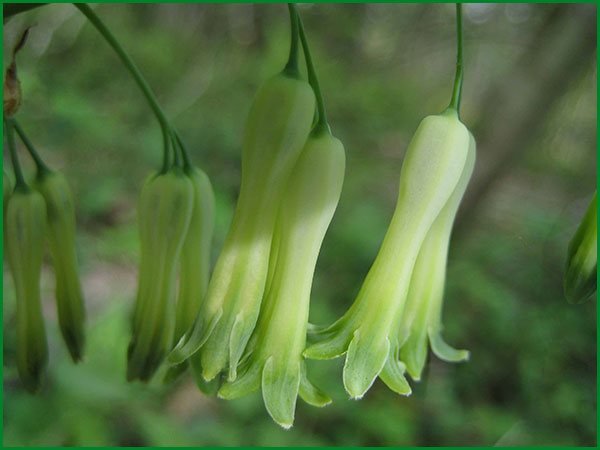

Flowering kupena
The flowering period begins in May and lasts about 3-4 weeks. After that, round dark blue and red berries with seeds are tied, which gives the plant a special decorative look.
Few flowers can boast of such undemandingness to themselves as bought, growing and caring for it does not take much time from flower growers.


Variegated foliage
Basically, you need to adhere to simple rules:
- The soil under the flowers should not be loosened, since this can easily damage the rhizomes close to the surface of the earth. Soil care consists in laying humus on top for the winter and mulching.
- Weeds are removed only in the first two to three years after planting. In a few years, they will no longer be able to break through the thick curtains.
- Watering depends on the type of planted kupena: the multiflorous one is moistened regularly, and the medicinal one tolerates drought and is watered only if there has been no precipitation for a long period.
- For the winter, the bushes are cut to a 5-centimeter height above the ground, before the onset of stable frosts, young plantings are wrapped in a layer of mulch.
Frequent transplants are poorly tolerated by the plant. The curtains can be left to grow in one place for about 15 years.
The garden lily of the valley is recognizable by its wide oval leaves and the most delicate snow-white or pinkish flowers. In the open field it can be either dwarf - the stem length does not exceed 10 cm, or high - the giant Chinese kupena reaches up to 150 cm in length.
Depending on the variety, it begins to bloom in May-June, the bell flowers are pleasing to the eye for about a month. After flowering, fruits with seeds appear on it, which are very poisonous. Legends are associated with the flower, and healers have used it as a medicine since ancient times:
- On the roots, you can find round impressions with a depressed core. For this, the flower was nicknamed "Solomon's seal". According to legend, the king gave it to the plant for its healing properties.
- The healing properties of the garden lily of the valley are multifaceted. Decoctions and infusions are used for purulent wounds, diseases of the lungs and stomach.
Growing kupena in the garden in the open field is carried out mainly in shady areas and partial shade:
- The plant will feel great when planted under garden trees.The shade from the leaves will prevent the sun from dehydrating the flower, and after flowering, the garden lily of the valley will retain its decorative properties thanks to its beautiful large leaves.
- The flower also adjoins well with shrubs, covering the emptiness of the trunks of the latter after growth.
- Suitable in a stone garden, rockery and on an alpine slide. It will stand out effectively in the vicinity of low flowers - pansies, daisies, asters. Will hide the drying shoots of spring flowers - daffodils or tulips. / Li>
Kupena is a perennial belonging to the asparagus family. Grows in temperate climates and subtropics. In our gardens, a well-bought kupena takes root, species and varieties differ in stem height, arrangement of leaves and color of flowers.
Reproduction of the "Solomon seal" is carried out by seeds and dividing the bush. The latter option is more successful, since in the open field the plant takes root better and begins to bloom faster. Open ground landing is carried out in the spring:
- The site for planting is dug up, loosened and fertilized with complex mineral fertilizer. It is important that there is no stagnation of moisture on the ridge.
- Drainage is added to each well. It can be sand with gravel.
- Plots are planted, sprinkled with earth tightly and watered abundantly.
- For fertile soils, one top dressing per year is enough. Poor soils are fertilized after flowering plants.
- Watering the plant is not often. Many varieties do well with rainwater irrigation.
- It is not necessary to loosen the perennial. Its roots are too close to the ground. Replace loosening with mulching.
- It hibernates well in the open field. You need to cover it if the temperatures drop below -20 ° C.
The garden lily of the valley is a shade-tolerant plant. Does not like bright open sun, because of it it loses its decorative properties. Feels good in shade and partial shade. In the garden, under fruit trees, it performs not only a decorative function, but also protects the site from weeds.
The Kupena flower propagates both by seeds and by dividing the bush. Seed reproduction is a long and laborious process. The sprouts will hatch only after 10 months of strict adherence to the cold-warm temperature regime. Sharing a bush is much easier:
- The bush needs to be divided approximately every 3 years. Each plot should get a part of the root with growth buds and a stem.
- Prepare a planting site - dig up, remove weeds, apply fertilizer and loosen.
- The rhizome is planted horizontally, no deeper than 10 cm.
- The distance between each seedling is 20 cm.
- Water liberally.
- After about two years, the purchase will take root, planting and care in the open field of the garden lily of the valley, as we can see, the process is not complicated, but long.
Plant features
Kupena has a strong, high peduncle, which bends in an arc towards the ground under the weight of the buds. The leaves of the plant are large, oval in shape with longitudinal grooves of light green color. White flowers have green, pink, cream edging.
Flowering kupena
The flowering period begins in May and lasts about 3-4 weeks. After that, round dark blue and red berries with seeds are tied, which gives the plant a special decorative look.
Reference. Kupena is known for its healing properties and is widely used in folk medicine. The rhizomes of the plant are rich in starch, together with young shoots they can be eaten. You should be extremely careful with berries - they are poisonous.
Popular varieties
Kupena is also known as the Solomon Seal. The plant belongs to the genus of plants of the Asparagus family. The area of their natural distribution is the temperate and subtropical belts of the Northern Hemisphere.
They can often be found in forests, meadows, bushes and on slopes.
Botanists have described several dozen types of kupena. The most famous among them are:
- bought medicinal - does not grow above 0.5 m.Large leaves grow on a faceted stem, buds are formed on thin drooping pedicels. The flowering period is late spring - early summer. Fruit is a dark blue round berry;
- kupena multiflorous - used as an ornamental culture and used as a medicine. An adult plant bush has a height of about 1 m. Oval-shaped leaves grow from the stem, in the axils of which 5-6 flowers are tied. The flowering period is June. In summer, blue berries ripen on the plant.
- fragrant kupena - differs in a bluish tint of green leaves. Representatives of this species are found with crimson bases and leaf veins. The average plant height is about 80 cm. The flowering period begins in mid-May and lasts about 5 weeks.
Botanists have described at least 50 types of culture, and many of them are decorative. However, in ornamental gardening, four varieties can be found:
- Medicinal bought. It grows in the shaded forests of the northern hemisphere. In height it reaches 1-1.5 meters, flowering is observed from late spring - early summer. The berries of this variety have a pronounced emetic effect.
- Fragrant kupena. In the wild, the growing area is the slopes of squat mountains and hills, shaded forests and lawns. In height, it can reach no more than 80 cm. The foliage of a bluish-green tone. Flowering begins at the end of May and lasts 4-5 weeks.
- The multi-flowered kupena is a favorite of gardeners. Often planted in hanging flowerpots and in open ground. Flowering begins with the onset of summer.
- Kupena is pink. Siberia and China are considered to be the territory of natural growth. The stem of the flower is straight with reddish blotches. Foliage is collected in groups of 2-3 pieces. The buds are formed from the axils of the leaves in several pieces. The perianth is pink. Flowering begins at the end of May. At the end of flowering, oblong red berries flaunt in place of the bud.
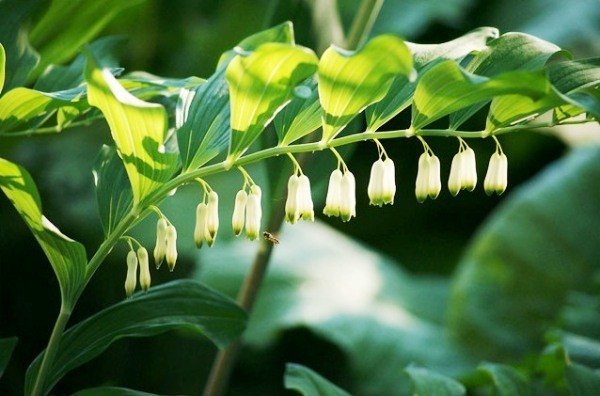

kupena multiflorous


fragrant bought
Kupena multiflorous or fragrant
Kupena multiflorous belongs to the Lily of the Valley family, has a rather modest appearance, but at the same time looks elegant. The Solomon seal plant prefers shady places. If the flower is planted in a too sunny area, its growth may not occur so quickly, and an adult plant will not delight you with its splendor. It is recommended to plant a flower under a tree - it will look beautiful in the form of thickets.
All over the world, no more than 50 types of kupena are distributed, they are mainly concentrated in Asia and Europe. In Russia, 2 main varieties are grown: fragrant or medicinal kupena, used in pharmacology, and multiflorous kupena, more often used for decorative purposes.
This plant is distinguished by a rather powerful root system, several erect stems, often located at a slight slope. In height, they sometimes reach 1.3-1.5 m. Wide lanceolate leaves on the stems grow vertically, as a result of which it seems that they are planted on it. And behind the size of the leaf, small tubular flowers peeking out of the axils, looking down, are often not noticed. They have a pale yellow color around the edges, tapering off towards the center. Some species have petals in cream and pink tones with a terry frame. At the end of flowering, fruits appear on the compartment, which cannot be consumed: they are toxic to humans.
Fragrant kupena refers to perennial plants, it does not even reach 70 cm in height: the average values for a bush are 40-60 cm.The length of the leaves ranges from 10 to 14 cm, the width is 2-5 cm.On the back, they are rough and dull, with silvery tint, glossy on the front, dark green.
The plant has a branched and long root. On the peduncle there are 1-2 white flowers blooming at the end of May.The dark blue fruit appears at the end of June. In nature, the medicinal bath can be found on the edges and between shrubs, in coniferous forests.
Garden lilies of the valley - planting and care
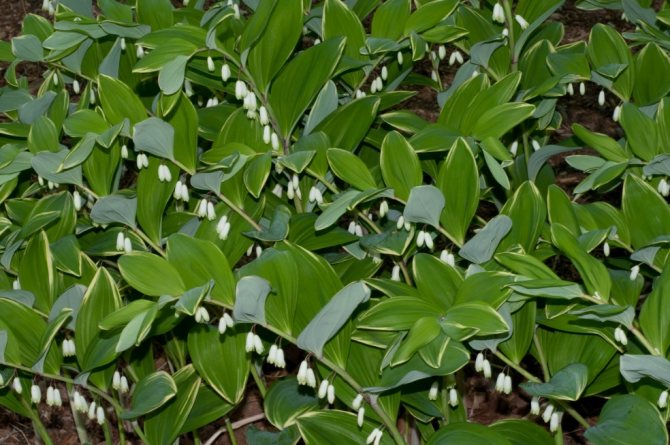

The garden lily of the valley blooms from May to June. Initially, buds hang down the lower part of the shoot from the leaf axil, then bell-shaped flowers bloom. Depending on the varietal variety, there can be pink, snow-white and cream tones.
The aroma of the inflorescence is pleasant. Flowering can last up to two months. If pollination occurs, a fruit is formed in place of the bud - berries of a red hue, which, after ripening, acquire a blue-black tone. Each berry contains up to 10 seeds.
Important! The fruits, together with the seed, are poisonous to humans and animals.
Description of the Kupena plant
Kupena (Polygonatu) is a plant belonging to the genus of lily of the valley, family of asparagus, family of liliaceae.
This flower has a graceful ribbed stem, decorated with bright green oval or lanceolate leaves with vertical veins.
It blooms in late spring - early summer. The flowering period lasts approximately 4 weeks.
The flowers are small, bell-shaped, white and cream-colored, slightly greenish towards the end of the petals. The aroma of flowers is pleasant. At the end of summer, round fruits ripen in the form of dark blue poisonous berries. The number of seeds in them varies from 2 to 9.
Distributed in mountainous areas, temperate and subtropical climates. Less common in tropical European zones, America and Asia.
This plant has other names: garden lily of the valley, Solomon's seal, raven berries, bloodworm.
There are several dozen subspecies of this plant, and each variety is characterized by the peculiarity of the color and shape of the inflorescences, the size of the bush, and the height of the stems. Gardeners predominantly cultivate two types of this flower: multiflorous kupena and medicinal kupena.
This is a moisture-loving shade-resistant plant that tolerates winter frosts well.
Garden lilies of the valley - planting and care
In a shady place, the compartment is allocated a plot with dense, moisture-absorbing, nutritious soil without stagnant groundwater. In such areas, the kupenas develop perfectly, forming dense lush clumps. Kupena tolerates a lack of nutrition, but poor soils that dry easily will not allow it to form powerful shoots. On such soils, the plants look pale, they retire earlier.
When planting, the kupena must immediately determine more space for it to grow. Large landings kupena look especially impressive.
Alcohol tincture
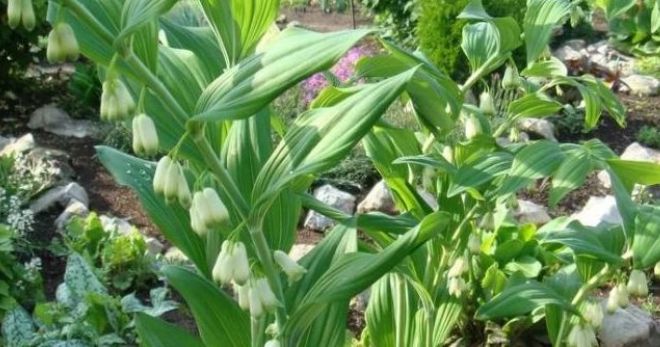

Most often, the kupen is propagated by rhizomes. The elbows of the rhizomes are fragile and break off easily. Planting is done in late summer, when the renewal buds are fully formed, or in early spring.
By examining the buds of the rhizome segment, you can determine whether the plant will bloom next year. Flower buds are larger, with a rounded end, growth buds are smaller, pointed. It is better to plant such segments in a separate growing area.
Before planting, it is necessary to apply a complex mineral fertilizer (especially on depleted soils) - 15 g per shoot, wood ash is also suitable. At the bottom of the shallow fossa (8 - 10 cm), drainage is poured and the rhizomes are laid at a distance of 15 - 20 cm from each other.
When growing, this gap can be reduced to 10 cm. The topsoil is mixed with compost and planting material is sprinkled on it. The soil is moistened, watering is necessary (in the absence of rain) for at least another week.
Kupena can be propagated by seeds, but this method is not very suitable for amateur gardeners, since seeds germinate slowly and often turn out to be non-germinating. And the plant will bloom, not earlier than in 3 years.
Kupena is often used to "refine" desert, shaded areas. This is a wonderful neighbor for a fern, dicenter.It is also planted next to hosts, tulips, irises and primroses, hellebore and tiara.
Almost any soil composition is suitable for the growth and normal development of the kupen, but it looks best when planted in partial shade or shade. The only requirement for soils is mandatory fertility.
On scarce plots, which are also located in the open sun, the garden lily of the valley will not look so impressive, and the purchase grows in such conditions much worse. When choosing a place for planting, it is worth considering the depth of the groundwater, because this plant does not tolerate liquid stagnation.
Kupena propagates easily by segments of thick rhizomes. Before proceeding with planting and caring for a bath in the open field, the rhizomes must be disassembled, paying attention to the buds. They are flower and growth.
Floral - larger, with a blunt ending, growth - smaller, pointed. Sections of rhizomes with flower buds are planted in a permanent place, they will give flowers next year. Sections of rhizomes with only growth buds are planted on a separate bed for growing. Plant transplantation is not only tolerated, but also loved.
The distance for planting is 15-20 cm, and for growing - 5-10 cm. After planting, a strait is needed. If the weather is dry, then daily for a week. The best time to plant and start caring for the bush is early spring, but you can also plant it in autumn - at the beginning of September. Caring for them is simple - watering, if dry, mulching after watering.
- The new planting site is cleared of weeds and dug to a depth of 20-25 cm. The soil is leveled and all boulders are developed.
- Mineral complexes, ash and compost are introduced. In the presence of heavy and dense soil, sand is added.
- In the process of placing the seedling in the hole, the rhizomes are laid strictly horizontally, deepening by 8-10 cm.
- It is necessary to arrange the planting at a distance of 15-20 cm. The soil in the holes is compacted and abundantly watered.
Flowering kupena
The key to the successful cultivation of this unusual plant is the observance of several conditions for choosing a suitable place. In order for the kupena to grow magnificently on the personal plot, planting and care in the open field is carried out in a shady place. It grows poorly in the sun and loses its decorative effect.


Fragrant Kupena
The plant is undemanding to soils, but it develops better on humus-rich, dense soils:
- Kupena does not tolerate the conditions of prolonged stagnation of moisture; soils with a high level of groundwater are not suitable for it.
- Before planting, it is advisable to apply mineral fertilizer to the ridges, after which it will be possible to do without feeding for several years.
- Favorably on the quality of the soil for the compartment will be affected by the embedding for the digging of wood ash.
Care secrets
Kupena is good because it requires minimal maintenance. With the right choice of a planting site, only periodic watering will be needed, however, it is necessary only with prolonged drought. So that after watering a dense crust does not form on the surface of the earth, it is mulched. It is not worth weeding the ground so as not to damage the rhizome. The weeds are simply pulled out.
In the fall, the shoots are almost completely cut off, leaving only hemp up to 5 cm high.Kupena hibernates in the open field without additional shelter. The plant is resistant even to severe frosts. In the spring, when the snow is melting, the roots may suffer from excess moisture in the soil. In the very first warm days, juicy greens will appear, which will grow intensively.
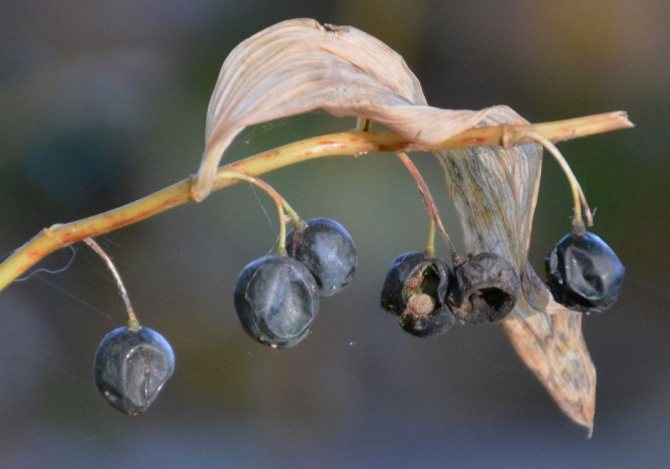

I bought excellent immunity and good resistance to parasites. Sometimes slugs settle in a dense crown. They can be collected by hand. A thin layer of ash or sharp eggshells on the ground also helps.
Flower reproduction methods
The kupena is propagated by segments of rhizomes.If the beauty is already growing in the garden, you can propagate it while it is at rest. In early spring or early autumn, the plant is dug up, the rhizome is divided into parts so that each has several buds.
When buying a rhizome, touch it; it should be firm to the touch. Its surface should be covered with many hair-like roots. You should not buy planting material that is sluggish or with sprouted buds.
Seed reproduction is rarely used in practice, seedlings do not retain hereditary characteristics, and seeds quickly lose their germination. In case of urgent need or a great irrepressible desire, you can sow the kupin with seeds.
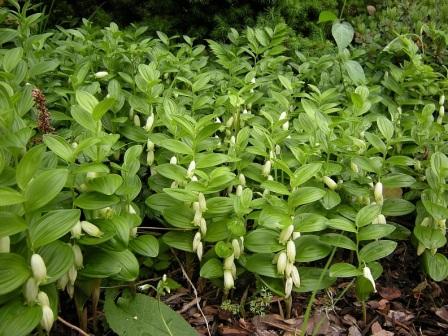

Kupena low - Polygonatum humile
You can breed a garden lily of the valley on a site in 2 ways: by seeds and by dividing rhizomes. The first method is laborious, and is usually not used by gardeners.
Division of rhizomes
With the vegetative method, the bushes selected for transplantation are pre-dug in. In this case, the separation of the rhizomes from the mother plant occurs. The plants are dug up and transplanted to a new location. The kupena will bloom in 2 years.
Seeds
This method is not very common among gardeners, since the flowering of a garden lily of the valley will have to wait 5 years. In addition, long-proboscis bumblebees are required for pollination of flowers (with the exception of the broad-leaved bumblebee).
For those who want to plant a flower on their site, reproduction is quite easy to master. To do this, use two methods - dividing the rhizome and seeds.
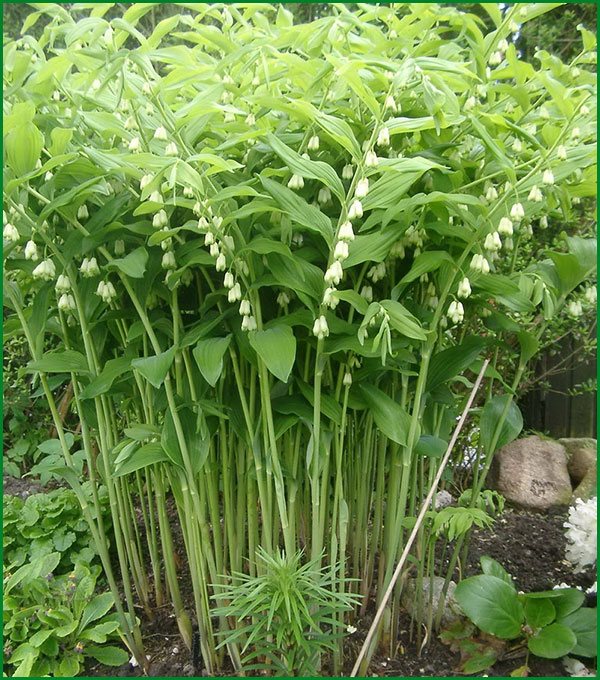

Growing bought in group plantings
With vegetative propagation, the plant develops and blooms faster. For this:
- The area selected for planting is dug to a depth of about 25 cm, applying mineral fertilizer (about 10 g per plant).
- In the planting holes, a drainage layer of crushed stone or sand is arranged, and filled with a nutrient substrate from the upper fertile layer of garden soil and compost.
- A part of the rhizome with a bud is separated from an adult healthy plant.
- The division is deepened into the ground to a depth of no more than 10 cm. The planting material should be placed horizontally in the hole.
- They dig in and compact the soil, moisturize the planting abundantly.
Any time of the year is suitable for this breeding method, but the plant takes root better if done at the end of August. Kupena takes root in a new place for about two years. In the third year, the plant begins to actively grow and form buds.
If there is nowhere to take an adult flower, growing from seeds is the only possible breeding option. This method is longer, often the appearance of the first buds has to wait about 5 years.
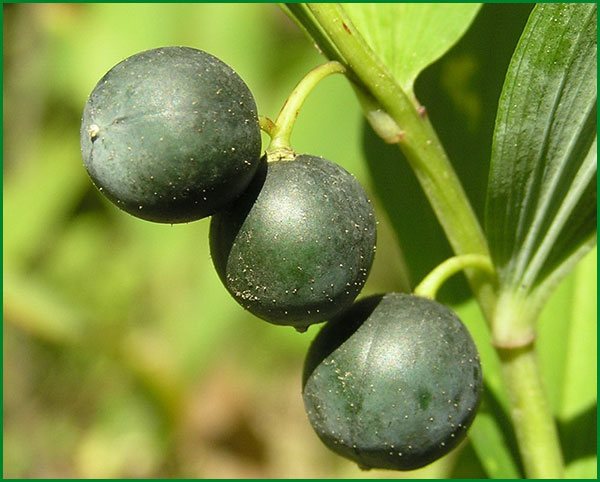

The fruits are bought
Kupen seeds need natural stratification. Therefore, they are sown before winter. They have a long period of development, and seedlings will hatch from the ground only in the second year in spring.
The culture is available for reproduction by the seed method and by the division method. The simplest and most effective method of reproduction of a polygonatum is the method of division:
- The bush is pruned, leaving several young stems and shoots with a bud of growth. The best cutting height is 10 cm.
- The plant is carefully dug up and the roots are cleaned from the soil.
- The bush is divided into several parts. The plant's rhizome is geniculate and rather fragile, so it will not be difficult to divide it. To prevent infection, the separation sites are treated with charcoal.
- The separated root with a bud or a young sprout is planted in a hole, deepening by 8-10 cm.
Immediately after planting, the seedlings must be watered abundantly with warm water. The soil is mulched with humus or peat. Subject to planting technology, new seedlings will be able to bloom in two years.
The flower grows slowly for the first two years. This lasts until the root is fully engrafted. After the bush begins to grow rapidly. It is recommended to divide the bushes every 3-4 years, and plant them in their original place.Otherwise, the flowers will crowd out all the neighbors in the flower bed.
Some gardeners prefer to try the seed propagation method. However, the acquired seed rarely produces an ovary. Also, germination rapidly decreases in seeds and mandatory stratification is required.
Choosing this breeding method, it is recommended to plant as close to winter as possible. Given the long development of plantings underground, the first sprouts will appear only next year. Given this feature, it is inappropriate to talk about this breeding method.
Remember! A seed-grown plant will only bloom after 3-5 years.
Reproduction bought by seeds
If there is nowhere to take an adult flower, growing from seeds is the only possible breeding option. This method is longer, often the appearance of the first buds has to wait about 5 years.
The fruits are bought
Kupen seeds need natural stratification. Therefore, they are sown before winter. They have a long period of development, and seedlings will hatch from the ground only in the second year in spring.
Place and soil for planting kupena
The place where the garden lily of the valley grows plays an important role in the correct formation and development of culture. In natural nature, the flower grows in shady forests. If you do not protect the bushes from the direct rays of the scorching sun, the cultivation of the beauty will not be crowned with success. The site should be shady, and partial shade is acceptable.


Kupena flower grows in a shady place
In sunny territory, the bushes will develop more slowly and lose their spectacular appearance. The best option would be to plant a kokornik near garden trees. So the bushes can form lush thickets and leave no room even for weeds.
Informative! Solomon's seal can grow up to 15 years in one place.
Kupena: combination with other plants
Kupena perfectly coexists with other plants that prefer shade and partial shade. She is friends with various types of ferns, hellebores, dicentra.


Kupena combined with a dicenter
Advice. If you do not keep the kupena under control, dividing the rhizome every few years, over time it can grow too actively, and will oppress, and even displace its neighbors in the flower garden.
Kupena - landing and leaving
It is necessary to water the polygonatum only in a little rainy period. At other times, the plant has enough moisture from groundwater and rainwater. After each watering, the bushes are mulched to prevent the formation of a crust on the soil surface.
Know! Excessive soil moisture provokes the addition of fungal infections and molds, as well as attacks by slugs and snails.


bought a garden
Top dressing
When growing a flower in fertile soil, it is enough to apply fertilizing once a year. In the spring, organic fertilizers (compost or manure) and a small amount of mineral complexes are poured into the soil.
Pruning
- planting plants must be free from weeds only for the first 2 - 3 years, then the purchase simply "drowns out" them;
- the buy is bypassed by the side of the disease, it only needs to be protected from snails, slugs, sawfly caterpillars;
- the plant needs watering only during the dry season;
- Kupen plantings do not need annual fertilization into the soil, but they will respond well to the spring addition of organic or mineral fertilizers directly to the garden bed.
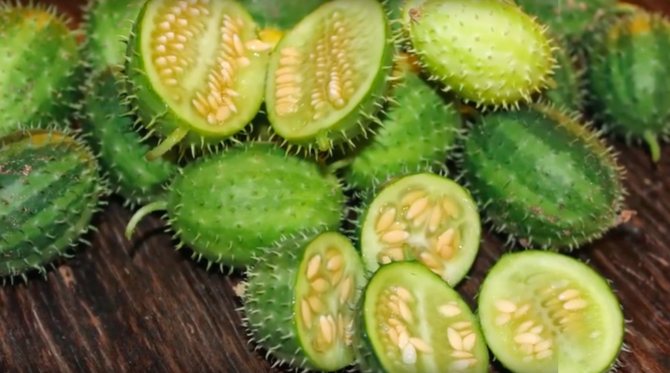

The plant can be planted in 3 to 4 years. In addition to the fact that planting material is obtained in this way, this event is necessary due to the strong growth of the buy. If this is not done, then it is able to displace other plants in group plantings.
Watering kupena
The selection of an irrigation regime largely depends on what kind of garden lily of the valley you are growing. For example, a multicolored kupena should be watered regularly, but in moderate doses, constantly maintaining the moisture of the soil, but not flooding the plant itself.At the same time, broad-leaved, medicinal and pink kupena, do not need frequent watering and tolerate prolonged drought well. Therefore, watering these types of kupins is necessary only when there has been no rainfall in a particular region for a long time, and the soil is very dry. Important! With an excessive amount of moisture in the soil, snails, slugs, mold and various fungal diseases often attack the kupena. Usually, after watering the plants, gardeners loosen the soil, but in the case of a purchased one, this option is unacceptable, since there is always the possibility of damage to the fragile rhizome, which is very close to the surface. Therefore, loosening is replaced by mulching.


Medicinal properties of polygonatum
The healing power of bought medicinal has long been well known and used by traditional medicine. With its help, such ailments as:
- headaches;
- inflammation of the respiratory tract;
- joint diseases - arthritis and gout;
- diseases of the digestive system;
- skin diseases.
It is used more often in the form of decoctions and infusions. Lotions help to heal shallow wounds. Alcohol tincture fights adolescent acne. Buy root juice is a proven method for whitening freckles.
Like any other drug, Kupena has its own contraindications for use. Therefore, reception for medical purposes is possible only on the recommendation of a doctor.
Having planted several bushes in a shady corner of his garden, in a few years it will be decorated with a rich carpet of wide bright green leaves with glimpses of snow-white necklaces of flowers. And without exhausting plant care measures.
Alcohol tincture
The medicinal type of culture is used to obtain decoctions and infusions. The medicinal features of the cortex are determined by the presence of cardiac glycosides and alkaloids in the composition. There are especially many of them in berries - convallarin, convallataxin and convallamarin.
The roots store a large amount of mucus and starch (which explains their use for healing the digestive tract), ascorbic acid, fructose, glucose and arabinose. Foliage includes in no small number ascorbic acid and flavonoids (glycosides of vitexin and cosmosines).


Also, the plant stores active elements that have blood-stopping, emetic, anti-inflammatory and analgesic, expectorant, blood-cleansing properties. In alternative medicine, it is customary to use the whole flower. The roots are harvested at the end of autumn, the stems and foliage - during the period of active flowering.


bought medicinal photo
Alternative medicine uses kokornik infusion for rheumatism and pain in the lumbar region, as well as inside in small doses for hemorrhoids and hernias. For pneumonia, bronchitis, stomach and duodenal ulcers, headaches, osteochondrosis and arthritis, use a decoction or alcoholic infusion of roots.
Tibetan medicine practices the use of medicinal kupena for edema of various origins, jaundice, diseases of the lymphatic system. More often, the plant is still used for outdoor purposes, especially given its excellent blood-stopping properties.
For your information! The Solomon seal plant is considered poisonous. But it was experimentally determined that during heat treatment (preparation of decoctions and infusions), toxicity is significantly reduced.
Healing properties
The rhizome and shoots of the kupena contain alkaloids, saponins, glycosides and other active substances. Thanks to them, the plant is used as a hemostatic, anti-inflammatory, analgesic, expectorant, enveloping agent. Fresh juice is used externally to remove freckles, treat abscesses, and heal wounds. With the help of a decoction, they fight stomach ulcers, bronchitis or pneumonia. Alcohol tinctures from the roots are used for headaches, heart failure, osteochondrosis, gout.It should be remembered that drugs based on kupena are good only in moderate dosage. Otherwise, they turn into poison. Before use, be sure to consult with your doctor.
Diseases and pests
Garden lily of the valley has increased resistance to diseases and pest attacks. But there are situations when the plant's immunity cannot cope with the infection. The greatest danger is represented by fungal diseases, which are actively developing with excessive soil moisture. This situation can lead to rotting of the rhizome and completely the entire bush.
For the purpose of treatment, fungicides with copper are used. Pests rarely attack polygonatum bushes. Basically, there is a neighborhood of slugs gnawing the lower leaves and stems. To combat slugs, you can resort to folk methods - treat the soil with wood ash or scald with boiling water. For strong attacks, it is advisable to use chemical molluscicides.
Advice! The best therapy is prevention. If proper care is provided, the requirements of the irrigation regime are met and the soil is properly mulched, the culture is not afraid of infections.
Indications for use
The use of funds based on the aboveground or underground part of the fragrant inside is indicated in the presence of the following diseases:
- ARI and ARVI;
- BPH;
- respiratory tract diseases;
- diabetes;
- cardiovascular diseases;
- myoma and mastopathy;
- diseases of the gastrointestinal tract.
External medicinal products are recommended for use in joint and skin diseases.
Kupena in landscape design
The perennial flower is suitable for planting in darkened areas and shady areas. It can be planted in separate areas or as part of a group flower bed. When decorating a landscape design, a kokornik can be combined with a decorative fern, hosta, hellebore, daylily and forest geranium.


bought in the neighborhood of the dicenter in the garden landscape
It is not recommended to plant low-growing crop species near the polygonatum. Strong greenery will interfere with small flowers and will shade the buds. As a monoclumba, the culture can be used to decorate the near-trunk zone of large trees.
Kupena is suitable for use in shady areas of the garden. It can cover the base of trees and bushes. It will be a mutually beneficial symbiosis: the crown of the plantations will protect the garden lily of the valley from the scorching sun, and he, in turn, will cover the unsightly tree-trunk circles.
In addition, the kupena can be used in rockeries, planting it behind low-growing plants: daisies, tenacious, pansies. It will serve as a background for irises, daylilies, garden geraniums. It will be good to combine with the same shade-loving plantings, like itself: hosta, ferns, dicentra, primroses, heychera.
Florists use garden lily of the valley for bouquets and flower arrangements. It can also be used for forcing. For this, pieces of rhizomes are planted in pots and kept in a warm room.
The plant is not replaceable in shady gardens. In them, she gets along well with the dicenter, ferns, doronicum. Suitable for growing in a rocky garden, suitable for joint planting with daylilies, hosts, irises, heuchera, tulips, primroses, forest geraniums. Often grown to cover desolate, unsightly areas of the garden.
How to preserve kupena rhizomes
As soon as the aerial part of the plant dies, it is time to collect the roots.... They should be dug out very carefully. Then dry in a warm room in the shade or under some kind of awning. When dried in the sun, the workpiece will lose its properties. Do not dry and store the rhizomes of the culture together with other plants and tubers. Preservation is ensured by placing raw materials in a shaded place. Wooden boxes or cardboard boxes are great.
Important! Do not touch the underground parts of the plant with your hands without gloves. Kupena is poisonous.
As for the collection of flowers, they are harvested as soon as they bloom. Use scissors to cut them off with pedicels. Then dry in a shaded place. You can store the material in glass jars or cloth bags. Medicinal decoctions are prepared from the roots and inflorescences.


Toxicity bought
The fruits are poisonous. Their venom can cause dizziness, vomiting and indigestion for several days. And some of them have pretty pretty blue berries. Therefore, if there are small children in the garden, it is better to abandon these plants for a while, or at least plant them away from the paths, somewhere in the back of the garden.
A source
Kupins fit perfectly into compositions in a natural style. Good landings are bought by arrays. Neighbors are suitable for kupins:
- volzhanki;
- hellebore;
- common ostrich;
- badan is hearty.
Dwarf species of kupena will decorate the foreground of a shady flower garden, combined with hellebores, saxifrage, liverwort.
Top dressing bought
The plant prefers saturated fertile soils. It grows very poorly on nutrient-poor soils and multiplies hard. Therefore, when the land becomes scarce, fertilizing should be done periodically. After planting on soil-rich soils, the kupena can not be fed for 2 years. After that, mineral fertilizers should be applied twice a year: in spring and during the flowering period. It is advisable to feed with organic fertilizers: manure or compost once a year, mainly in early spring, after the first shoots appear. They can be scattered dry directly around the flower and neatly between the plants, and then mulch the soil. In addition, solutions can be made from organic matter by insisting them in warm water for a week, at the rate of 1:10. At the end of the period, root watering is performed. This feeding should be done several times per season. Do not water the plant during the day or in extreme heat. It is advisable to choose the time in the evening or early morning
Gardeners reviews
On flower and garden forums, you can not only get information about planting and caring for a bath in the open field, but also read the reviews of the owners of this wonderful flower.
Svetlana, 41 years old, Dzhankoy: “For many years, a medicinal purchase has been flaunting on my flowerbed. Bushes look great both at the time of flowering and after. I really like that her inflorescences look like lily of the valley.
Reading the description of the culture, I learned that it is used in traditional medicine. I was always skeptical about such methods of treatment, but at one point a wound on the leg became inflamed. Remembering the healing properties of kupena, she treated the wound with juice diluted with water in a 1: 1 ratio.
Ekaterina, 38 years old: “Every spring I try to plant some new crop on the site. And given that there is little time left for the garden, I choose cultures that are unpretentious in care. Kupena is just such a plant.
Kupena attracts by the fact that it quickly fills the voids on the site. The bushes grow so densely that even weeds do not have room in the flower bed. In the winter I do not cover the flower bed, I just cut off the bushes after the stems have dried.
During the time that the flower grows on my site, the thought never arose in my head to get rid of it. On the contrary, with each new season, Kupena pleases with a large number of young shoots and lush flowering. "
Further care
Few flowers can boast of such undemandingness to themselves as bought, growing and caring for it does not take much time from flower growers.
Variegated foliage
Basically, you need to adhere to simple rules:
- The soil under the flowers should not be loosened, since this can easily damage the rhizomes close to the surface of the earth. Soil care consists in laying humus on top for the winter and mulching.
- Weeds are removed only in the first two to three years after planting.In a few years, they will no longer be able to break through the thick curtains.
- Watering depends on the type of the planted kupena: the multifloral one is moistened regularly, and the medicinal one tolerates drought and is watered only if there has been no precipitation for a long period.
- For the winter, the bushes are cut to a 5-centimeter height above the ground, before the onset of stable frosts, young plantings are wrapped in a layer of mulch.
Frequent transplants are poorly tolerated by the plant. The curtains can be left to grow in one place for about 15 years.
Application in cosmetology
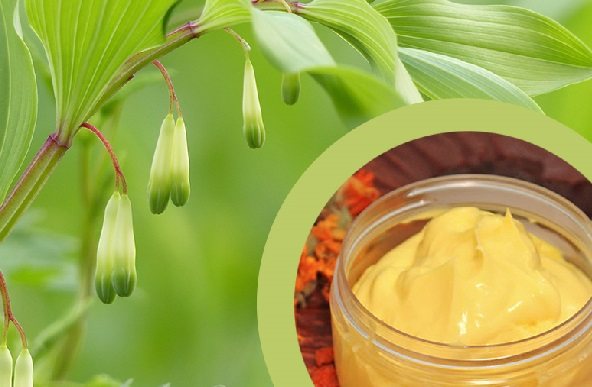

Due to its beneficial properties, Kupena is included in many cosmetics.
The cosmetology sphere also did not disregard the purchase. An essential oil for the skin is prepared from this herb, decoctions are made from its flowers, and natural creams for the body and face are prepared. If you wipe the skin of the face with the essential oil of the plant, the product will help to cope with expressive freckles and pigmentation. It is believed that essential oil fights not only existing stains, but also their possible appearance.
A decoction of Kupena flowers can be considered a skin cleanser. It helps to remove external defects of the dermis - redness, irritation, rashes and even acne.
Purchased at registration of the site
Kupena is good after flowering. It has curved shoots that only die off in autumn. This perennial is often used for landscaping shady places, but it also decorates well-lit areas.
Kupena looks great next to stones and snags. Especially if they are covered with thick moss. It can be safely planted at the edge of decorative pools and in rockeries, if there is a place with fertile soil there.
In flower beds, it looks amazing next to ground cover plants, for example, with a tenacious (ayuga), monet lobe, periwinkle, filamentous veronica, etc. A wonderful neighborhood - with a garden cuff, which emphasizes the beauty of other plants (article “Cuff: a garden plant or a useful weed? "). I have a lot of bulbous primroses (crocuses, scilla, etc.) settled around this perennial. They have been living their own lives on our site for a long time and appear in the spring even in the most inappropriate places. Kupena looks amazing next to white lilacs.
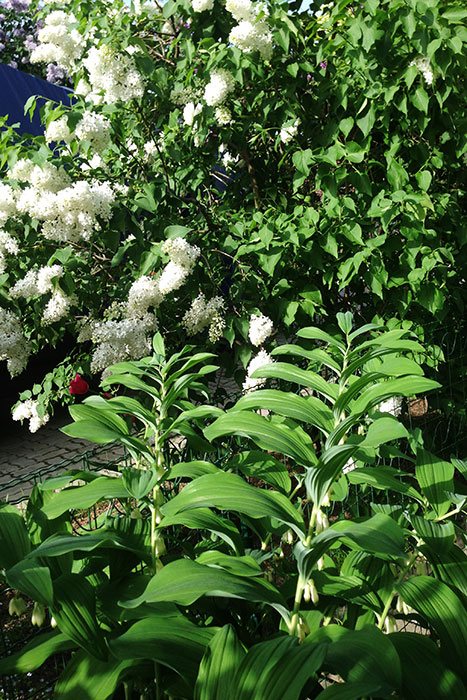

Blooming kupena and white lilac
Medicinal bought - properties and use in traditional medicine, contraindications
In the article, we discuss the medicinal bush, its botanical description, chemical composition, medicinal properties and field of application. You will learn how to use Kupena to reduce joint pain, heal a bruise, relieve symptoms of prostate adenoma and prevent cardiovascular diseases.
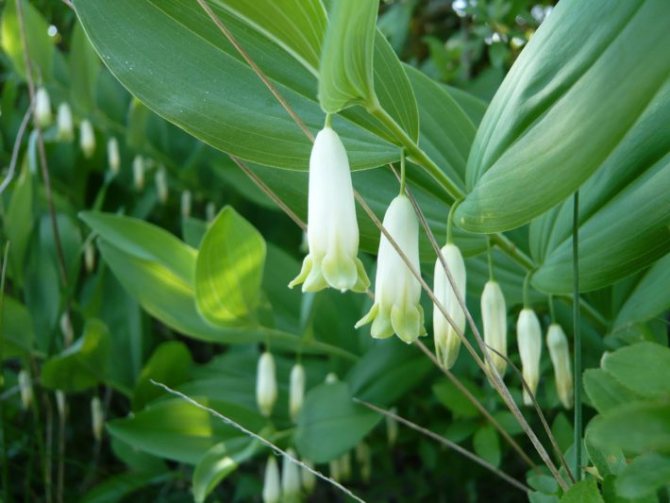

Appearance of the medicinal product Kupena officinalis, or fragrant kupena (Polygonatum odoratum) is a herbaceous perennial plant of the genus Kupena (Polygonatum) of the Asparagacea family. Kupena is a poisonous plant.
The popular name of the plant is the Solomon seal, because of the round traces remaining on the rhizome at the attachment point of last year's dead stems.
Other synonyms for kupena are pharmacy kupena, kokornik, wolf eyes, wolfberry, wolf berries, wolf apples, wolf grass, raven's eyes, raven, smoothie, crane pods, crane, bloodstain, hare cabbage, kupena-lupena, blood poison, lily of the valley eyes, wild hellebore, tyrlich, larch
When growing, planting and care in the open field does not require special skills. The plant can be planted on any soil. There is no need to take care of him, since the kupena grows in the beds in the same way as in the forest.
Related article: Mint-leaved basil - useful properties, description
Chemical composition
Cupena's medicinal properties are demonstrated by all parts of the plant. Fresh perennial leaves help to heal wounds, fruits and rhizomes are also used in folk recipes. But at the same time, all parts are poisonous, therefore the application should be extremely careful.
Chemical composition of perennial:
- rhizomes are rich in starch, mucous substances, fructose, alkaloids;
- Vitamin C and flavonoids are found in the leaves;
- cardiac glycosides are found in fruits, they accumulate in berries in large quantities, they are represented by covallaramin, convallarin, and convallatoxin.
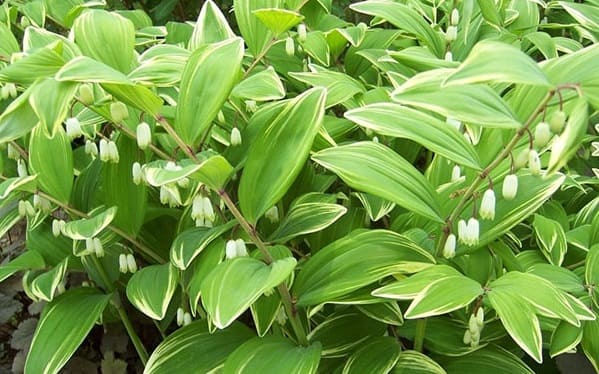

Have bought are considered useful - leaves and rhizome
The green mass of grass is usually used in the treatment of bronchopulmonary ailments; treatment with a medicinal bath causes its pronounced expectorant effect. Glucose, fructose, arabinose are also noted in the composition of the plant.
Bath care
This plant is absolutely undemanding to care for, it is quite capable of existing and developing independently, due to the fact that the kupena is a forest flower.
But she will gladly accept your attention and care, responding with greater splendor of the bushes and generous flowering.
Fertilization and feeding
If the soil where the garden lily of the valley grows is fertile enough, and the planting pit was well filled, then one top dressing per season will be enough for it.
It is usually done in the spring or early autumn: scatter over the area with the purchased last year's manure or mature compost, adding a handful of complex fertilizers.
Watering and loosening the soil
Watering the kupena should be done only in dry times, but you should not get carried away with this process.
Do not turn the planting site into a swamp in order to prevent root rot.
Make sure that the ground in the clearing just retains moisture, although these flowers tolerate a short drought quite persistently.
This plant can be content with rainwater and groundwater.
Due to the fragility of the rhizomes and their shallow location, you should not loosen the compartment, but so that a crust does not form on the surface of the soil, use mulch - under it the soil retains moisture and friability for a long time.
The use of the purchased medicinal
In folk medicine, decoctions are used, tinctures are bought. It is used for:
- prostate adenoma;
- mastopathy in women;
- myoma and fibroma of the uterus.
For these diseases, it is enough to use 10 drops of tincture every day after breakfast. Alcohol tincture is used for pain relief in sciatica, gout, rheumatism.
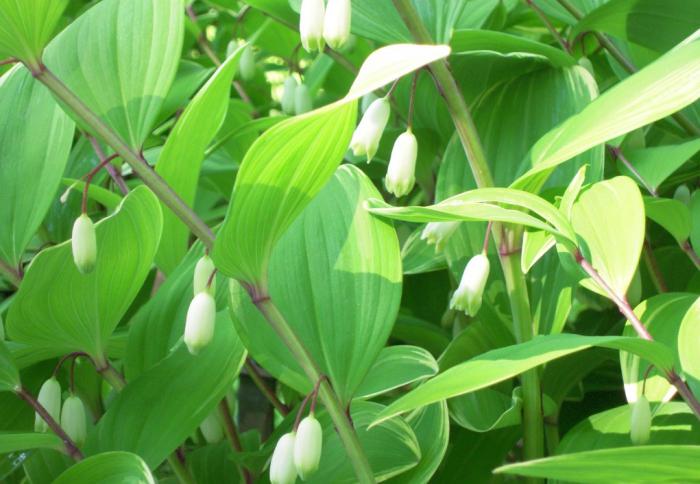

Kupena medicinal (appearance)
Leaves, berries are used for bathing after the birth of a child.
The herb infusion is used as an antipyretic agent for bronchitis and a diuretic for renal pathologies.
Fresh leaves are used to treat wounds, panaritium, erysipelas. Leaves scalded with boiling water are useful for poultices of bruised areas.
Important! Berries are rarely used because they can cause serious poisoning.
Root bought
Cupena root healing properties are most widespread in the treatment of many diseases:
- Powdered root of this plant is used for fractures, animal bites and aches caused by rheumatism. This powder is applied to the sore spot.
- A decoction from the root is used to treat hemorrhoids (it is added to sitz baths).
- The infusion from the underground part is used to prevent sunburn from darkening the skin. In the old days, this remedy was used by girls to preserve ruddy skin.
- A decoction of the root is used for edema, pain.
- Alcohol tincture of the rhizomes of this plant is used to treat stomach diseases.
- For the treatment of burns, herbalists used root parts, which were “baked” in ashes before.
- Juice from fresh rhizomes is used to remove freckles (it is used pointwise).
Kupena rhizome preparations are prepared as follows:
- To obtain a decoction, 1 tsp. crushed raw materials are poured with a glass of boiling water, insisted on a water bath, cooled and filtered. It should be taken in a tablespoon three times a day.
- A decoction in milk is prepared by placing 50 g of chopped rhizomes in a clay pot in 3 cups of the product. Next, you need to evaporate this mixture until a third of the original volume remains.Then strain it while hot. Drink with a hernia 1 or 2 tablespoons. three times a day.
- A tablespoon of fresh rhizomes is poured into 500 ml of boiling water, heated for several minutes and, wrapped, kept for 3 hours. Then strain this broth and drink 2 tablespoons each. for rheumatic pains, hemorrhoids. The same decoction is used to treat bruises, abrasions, pustules and other skin pathologies.
How to use a coupon
What is all that the purchased medicinal use is one - the creation of medicinal charges and the preparation of tinctures and decoctions for the treatment of various diseases. Although it is possible to use kupena in landscape design to create decorative thickets in a rocky garden and planting trees near the trunk of a tree.
In folk medicine, the most popular remedy is tincture bought with alcohol. The drink is a prophylactic and therapeutic agent for prostate adenoma in men, mastopathy, uterine fibroids and fibroids in women.
Ingredients:
- Dry roots - 50 g.
- Alcohol 70% - ½ l.
How to cook: Grind the roots of the plant using a blender, cover with alcohol and put in a dark place for 30 days. Strain the tincture before use.
How to use: For the prevention of diseases, take the medicine 1 time a day, 10 drops after meals, and in the treatment of diseases - 2 times a day.
Result: Cupena root tincture will reduce the risk of breast, ovarian and uterine cancer, will have anti-inflammatory and strengthening effect.
A decoction of the plant helps in the treatment of insulin-dependent diabetes, coronary heart disease, atherosclerosis and other diseases of the cardiovascular system.
Ingredients:
- Dry roots - 40 g.
- Water (boiling water) - ½ l.
How to cook: Grind dry roots into powder in a mortar or blender. Pour boiling water over and cook with the lid closed for 30 minutes.
How to use: Take the broth 4 times a day for ⅓ glass, regardless of food.
Result: Rhizome of medicinal kupena increases the amplitude of heart contractions and slows down the rhythm of the heart, strengthens the capillary walls.
Due to the fact that the purchase is poisonous, it is often used not internally, but for external application. A decoction from the root of the plant is effective for joint pain and bruises.
Ingredients:
- Dry roots - 100 g.
- Water (boiling water) - 1 liter.
How to cook: Grind the roots with a blender, put in an enamel saucepan, cover with boiling water and cook over low heat for 30 minutes. Insist the broth for 2 hours, then strain through several layers of gauze.
How to use: Cleanse the skin on the sore spot. Soak a piece of fabric in the broth and apply to this place. Cover the compress with plastic and secure with a bandage.
Result: Compresses from the medicinal plant quickly reduce inflammation in bruises, heal wounds and burns, relieve back pain and gout.
Fresh root decoction
Brew a spoonful of fresh rhizomes in half a liter of boiling water, take it on the fire and boil, remove from the stove, then leave for a couple of hours, strain. Use internally for hernias, back pain, rheumatism, hemorrhoids. Externally use for compresses, lotions and washings with bleeding abrasions, bruises, gouty and rheumatic pains, pustular diseases.
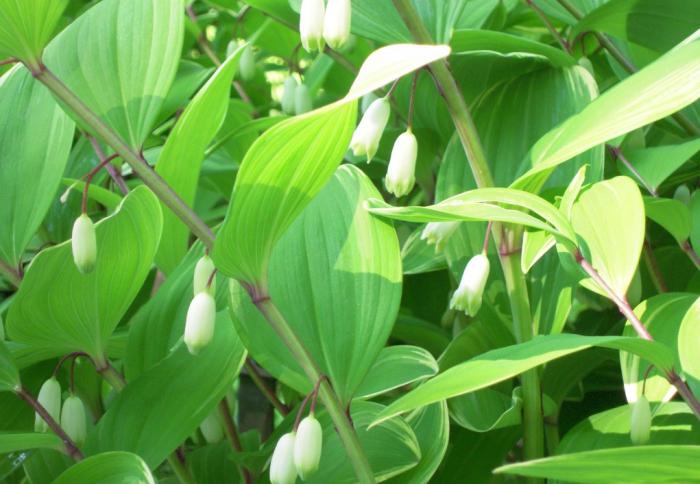

What does it look like
The height of the herbaceous plant is from 30 cm to 70 cm. The rhizome is thick, knotty with an arcuate curved root, located horizontally in the soil. The stem is long, faceted, curved with a yoke. Small leaves are facing one side of the stem. They have an oblong-elliptical shape, sometimes ovoid. The upper part of the leaves is green, the lower part is blue-green, matte.
Flowers are located in the corners of the leaves - as can be seen on the medicinal photo, white or white-green. Flowers drooping, glabrous, tubular-bell-shaped. Flower formula purchased: * PCa (6) A3 + 3G (3). The plant blooms in May. The fruit is a blue-black ball-shaped berry.
Plant properties
Cupena's healing properties are legendary, and from the diseases that she heals, you can make a medical reference book. For a long time, people noticed that this unsightly forest flower works wonders, they began to cook decoctions from it and make tinctures, the recipes of which were passed on to the modern generation. Herbal infusion helps to fight migraines, bronchitis, pneumonia, rheumatism, digestive tract problems.
- The magic kupena boasts the following properties:
- pain relievers;
- antipyretic;
- anti-inflammatory;
- expectorant;
- hemostatic;
- disinfecting;
- wound healing.
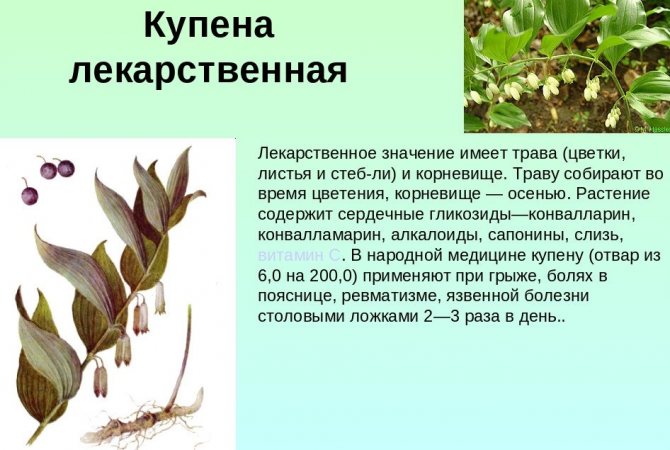

Root juice is used for skin whitening, treatment of dermatological diseases... Lotions from kupena heal wounds and help to recover faster. Grated infusion is used for stomach problems, to reduce the symptoms of hernia and ulcers.
Did you know? In ancient times in Russia with roots baked in ash, the kupenas treated the master's cattle. When animals were infected with a skin gadfly, the drug was applied to the wounds, which helped to bring out the insect larvae and soothe the pain.
Plant characteristic
This plant is characterized by a powerful, gnarled, horizontal rhizome, arched roots. The rhizome is very thick and gnarled. It can live for several years. In winter, only the stem and leaves die off. It is characteristic that the rhizome is located horizontally in the depth of the soil. With the onset of spring, several fresh shoots grow from it.
The height of the stem is up to about 60 cm. At the top, it is arcuate, knotty, with edges. Every year, the stem leaves a scar on the rhizome, like an imprint of a signet.
Interesting! It is because of this feature that botanists gave the second name to the plant - "Solomon's seal".
The leaves of this plant are facing only one direction. They are placed alternately. The shape is oblong-oval, ovoid. Leaves are sessile, glabrous or slightly pubescent. Above they have a light green tint, from below it changes to blue-green. Leaf venation is longitudinal-arc.
The flowers of this plant are white, naked, drooping. They are tubular-bell-shaped. The corolla is fused, six-toothed. Blooms during May - June.
The fruit is a bluish-black berry, poisonous.
Contraindications
Individual sensitivity to the components of the product is the first and main point that cannot be predicted. Monitor the reaction of the body, respond in a timely manner to negative symptoms.
Kupena can not be used in any form by pregnant and lactating women. The harm to the mother and baby can be very serious. When applied externally, Kupena is potentially indicated to everyone, but with a condition, if you are sure of what you are doing.
A strict contraindication to the use of kupena will also be the minor age of the person who is supposed to be treated with it.
Kupena is, in most cases, a medicine for exclusively external use.
If during the application there is a suspicion of an overdose of a herbal remedy, an urgent need to contact a doctor.
Varieties
The genus Kupena includes 50 varieties of a perennial plant. In decorative floriculture and for medicinal purposes, Kupena medicinal (fragrant) (Polygonatum odoratum), Kupena multiflorum (Polygonatum multiflorum "Variegatum") and Hybrid Kupena (Polygonatum hybridum Bruegger) are grown. In comparison with the purchased drug, the description of the multi-flowered and hybrid purchase is different.
The multi-flowered kupena or kupena variegatum grows in the European regions of Russia and the Caucasus, in Asia Minor, China, Japan and North America. The stem of the plant is slightly inclined. It has oval-lanceolate leaves. In the axils of the leaves - 5 flowers. In a multiflorous bush, planting and care begins in June.
Hybrid Kupena is a plant obtained as a result of interspecies crossing of a fragrant and multi-flowered Kupena. The leaves of the plant are erect, up to 15 cm long, bright green above and bluish below. If you look at the hybrid buy photo, you can see features of both types. A spectacular arcuate bend of the stem, like in a fragrant Kupena, and 3-5 flowers in the axils of the leaves, like in a multiflorous Kupena. Hybrid kupena frost-resistant, begins to bloom in May.
Purchased medicinal in traditional medicine recipes
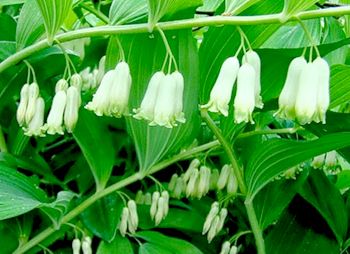

Kupena officinalis is a perennial plant belonging to the asparagus family. The stem is glabrous, has edges and nodules on the surface, slightly inclined. The height of the plant varies from 30 to 70 cm. It is similar to lilies of the valley, since the flowers are of the same shape - bells, located on the stems, 1-2 in the bosom. The arrangement of the leaves of the Kupena differs from the lilies of the valley, they are located on the stem alternately, elliptical in shape, green above, and glaucous below. The plant blooms in May, about five flowers bloom at the same time on one stem.
The most common types:
- Medicinal purchase. Another name is pharmacy, raw materials include grass rhizomes. In the northern hemisphere, it is found almost everywhere. Grows in forests, between shrubs. Plant height is about 50 cm. The stem is knotty, with edges. The leaves are large, the flowers are white, regular in shape, the fruits are bluish-black berries. The plant is known to induce violent vomiting.
- Fragrant kupena. The Far East, Siberia, the western regions of Europe and the Ciscaucasia - this plant can be found here. Its height reaches 80 cm, flowering begins in mid-May. The grass grows in shady places, loves moisture. You can find it both in the forest, in the clearings, and on the slopes of the mountains. Differs in the coloring of pedicels, veins and leaf bases in a raspberry-red color.
- Multi-flowered bush. It multiplied in the European zone of Russia, found in China, in the Caucasus, in Japan. The grass is up to 90 cm high, the stem is inclined, with pointed leaves that have an elongated oval shape. Flowering occurs in June, the plant is used for decorative and medicinal purposes.
In Russia, the growth of seventeen species of kupena, growing in coniferous, deciduous and coniferous-deciduous forests, is noted. The grass often appears in ravines, in bushes, sometimes in meadows.
Interesting Facts
Since ancient times people called Kupena medicinal the "Solomon seal", because on the rhizomes one can find semicircular depressed traces, like from a seal, they are left by old stems that grew last year.
The popular name "foam-lupena" was widespread. This is due to the fact that among people there was a belief: if you wipe your face with a kupena, which has an even number of leaves on the stem, then the skin on your face will peel off. In the opposite case, the grass was called foam - washing with it brought the cosmetic effect of whitening and getting rid of age spots.
Tibetan doctors believe that medicinal kupena has properties that prolong a person's life, and therefore it is included in the treatment fees.
The original beauty of flowers and berries bought with success is used by designers when decorating plots and gardens. And Caucasian chefs add leaves to salads, the rich content of vitamin C fully justifies such a recipe.
Veterinarians use rhizomes baked in hot ash to rid livestock of parasite larvae that gadflies deposit in the skin of animals.
If you believe astrobotany - the science of the interaction of stars and plants, then Mercury controls the bath - the planet responsible for the growth and development of personality, the ability to communicate and establish relationships with other people.
People call the kupena a deaf lily of the valley - because of the similarity of flowers and leaves with lily of the valley, crane pods, parsley.Black and blue berries up to 1 cm in size, resembling the eyes of birds or animals, have become the reason for such names: magpie or wolf's eyes, raven, wolf berry. It is known that grass is also called smooth, forest hellebore, tirlich.
Composition and benefits
In the manufacture of medicinal products, all parts of the plant are used. Fresh leaves heal wounds, boiled ones are also useful. Fresh rhizome juice is also a well-deserved success. It should be remembered that the grass and its parts are very poisonous, so you need to use them with great care.
- Rhizomes. They contain glycogenin, starch, mucous substances, alkaloids, fructose.
- Leaves. They contain vitamin C, flavonoids.
- Fruit. Cardiac glycosides in berries accumulate in considerable quantities. These are convallaramin, convallatoxin, convallarin.
The effectiveness of drugs from the drug purchase for a variety of diseases has been noticed for a long time, therefore this name is often found in folk recipes. The plant has such beneficial properties as:
Expectorant action
The herb helps with coughing, relieves inflammation, liquefies phlegm, removing it from the body with colds and pneumonia.
Anesthetic effect
For rheumatism, sore joints, a tincture from a plant is used for grinding. Helps relieve pain in gout, arthritis. The people actively used a decoction of the herb for headaches, but it only relieves the symptoms without curing the causes.
Decongestant and blood-purifying property
Diabetes, dropsy and edema of various origins are well treated with the use of medicines from the purchased in combination with medicines. The emollient and diuretic effect allows you not to use substances of artificial origin, which create an additional burden on the body.
Enveloping and styptic effect
Thanks to him, medicinal kupena became widespread in medicine in the treatment of gastrointestinal ulcer disease. The starchy components envelop the mucous membrane, softening the passage of food in the stomach, preventing damage and possible bleeding. In gynecology, these properties of kupena are also used in the treatment of inflammatory processes and bleeding.
Skin brightening and restoration
Kupena medicinal is used in cosmetology for problematic skin diseases, acne treatment, for example. The lightening effect of the plant is used when it is necessary to remove pigmentation, freckles. In this case, one should remember about the toxic effect on the skin and the possibility of getting a chemical burn with prolonged contact. A decoction of the plant is popularly used when bathing newborns.
Toning property
It relieves the condition of heart ailments, helps with recovery from serious illnesses. In case of poisoning, it is used as an emetic. An infusion based on wine from the leaves in folk medicine has been known as a good drug that reduces the risk of hallucinations.
Related article: Basil aquiferous - useful properties, description
Collection and procurement
The upper, herbaceous part of the plant, flowers and leaves are harvested when the medicinal plant begins to bloom. In order for the kupena not to die after such a collection, the leaves are cut off in the amount of a third of the total. The rhizome is dug up in the last days of October - early November. It is better to collect the plant in places far from dusty roads, polluted megacities. It is best to go to the forest.
The collected herbaceous parts are laid out in a thin layer in a room that is well ventilated, but does not allow direct sunlight. The dried raw material becomes brittle, loses its color and odor intensity. The roots must be thoroughly rinsed from the remnants of the earth, then you need to inspect, remove dead or spoiled parts of the rhizome.They are dried in special dryers, or in a room with a very warm temperature regime.
The berries are harvested when fully ripe, then dried, sprinkled as rarely as possible in a warm place, with constant access of fresh air. Harvesting in dry weather and mandatory sorting of raw materials will help prevent spoilage during drying. Two years is the optimal storage period for plant harvesting, in a dry, dark place. It is best to put it in a linen or cotton bag. The dried material should not be wet, regular checking for mold will help prevent damage to the herbal collection under unfavorable storage conditions.
Folk recipes
Fresh Juice
It is poured into wounds to prevent suppuration. For bruises, use leaves scalded with boiling water as lotions. The recipe is also effective for panaritium, erysipelas.
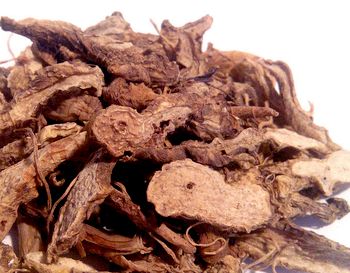

Compress for joint pain
40-50 grams of dry crushed root kupena is boiled in half a liter of water. A strained and infused broth is recommended for lotions to a sore spot.
A tablespoon of dry kupena leaf is poured with a glass of boiling water. Insist for about an hour and strain. Drink for kidney diseases, inflammatory gynecological processes, arthritis and jaundice, one spoonful three times a day.
Fresh root decoction
A decoction from it is used internally for hemorrhoids, hernia, rheumatic attacks. It is possible to wash damaged skin with abrasions and bruises, abscesses and acne. It is simple to prepare the broth - a spoonful of crushed root is taken for half a liter of boiling water and brought to a boil again. After insisting for a couple of hours, strain.
Milk broth
It is used in the treatment of hernia, ulcers and is cooked in a clay pot. Three liters of milk is poured into a pot, adding 50 grams of rhizomes. Simmer over low heat until one third of the volume remains. The resulting liquid is immediately filtered and then drunk three times a day on a spoon.
Anthelmintic
For use, a decoction is made from a glass of water and a spoonful of crushed root, and it is prepared in a water bath, insisting for half an hour. They drink a spoonful three times a day, and this recipe is good for colds, coughs.
Alcohol infusion
Purchased leaves are taken fresh. 100 grams of them are poured with medical 70 percent alcohol, you need 100 ml. It is infused for 10 days in a dark, dry place, periodically the infusion must be shaken. Then it is filtered, thoroughly and several times. Such a composition is used in drops, their amount is selected individually. Helps with gynecological diseases and bronchitis.
Contraindications
Since the medicinal product contains poisons, treatment with its help should be carried out under the supervision of an experienced homeopathic doctor, herbalist. Only a properly selected formulation and dosage can be beneficial, not harmful. In general, it is not recommended to use drugs with a purchased medicinal product if:
- a person has not reached the age of sixteen, since the child's body is most susceptible to the effects of drugs containing alkaloids;
- the woman is pregnant or breastfeeding;
Symptoms of berry poisoning are similar to those of an overdose of cardiac glycosides. Vomiting attacks are the most obvious of them.
Household use
Among the people, rhizomes were used to alleviate the fate of cattle when infected with gadfly larvae. Tincture from it was used to increase the appetite of beetle animals, as it enhances the contraction of the scar. The addition of drops of alcoholic tincture of Kupena officinalis to their food increased the secretion of gastric juice in livestock. No wonder, grass is often eaten in the wild by deer and red deer. The anthelmintic property of the plant also plays a positive role.
The problem of landscaping a garden plot in its shady, humid places can be easily eliminated with the help of a medicinal purchase. Its unpretentiousness and decorativeness made the grass very common among gardeners.Lily-of-the-valley flowers and dark berries are eye-catching. The vibrant green of the leaves will enliven a dull area throughout summer and early fall. Once planted, the kupena will grow on its own, every year delighting with smooth leaves and beautiful berries. The plant propagates by rhizome, the seed method is more laborious. Even minimal maintenance will provide a wonderful green cascade in the garden or on the site.
After flowering, the bushes of the medicinal plant look great, effectively shading other flowering plants. Adjacent pansies, irises, lilies or tulips will have a beneficial green backdrop throughout the summer season. Improvement of marginal lands near trees is another advantageous side of planting bought medicinal.
Feedback on the results of use
We cured my son's stomach ulcer with an infusion from a medicinal product. An old Korean advised us - we are grateful to him
Tatiana Dracheva
Dry roots of the kupen, ground to a state of powder, together with asparagus roots (in the same form) help with tumors.
ewgeny gasnikov
Kupena and mysticism


Kupena is often called the "Solomon's seal" or "the seal of Solomon". There are 2 legends that speak of the kupin and the biblical king Solomon. So, in one legend it is said that the king, who lived a very long life, decided to mark the bush with his own seal, which allowed people to quickly find medicinal plants that prolong life. Another legend says that Solomon ordered to put the same pattern on his seal that he saw on the rhizome of the kupena. Today, amulets are made from a dried small piece of rhizome "with a seal" that can strengthen family ties. The parts of the root cut off by the peasants had a shape similar to a cross. They used them as a talisman against damage, the evil eye, and the wrath of the heavenly powers. Also, this rhizome is widely used by healers for a hernia conspiracy.
A stem with an odd number of leaf plates was called "foam" and the infusion made from it was used to wash the face. This helped to get rid of freckles and other age spots. An infusion from a stem with an even number of leaves, which was called "lupena", was prepared using spring water. They also washed their face to get rid of damaged skin.
Spread
Pharmacy Kupena prefers moist soil of coniferous, coniferous-deciduous and deciduous forests... Grows in shrubs or on slopes. Geographically, it is found in Russia, where 17 plant species are predominantly distributed in the Caucasus, Siberia and the Far East.
Also grows in Scandinavian countries: Denmark, Finland, Norway, Great Britain. It is found in the regions of Central Europe: Germany, Czech Republic, Poland, Austria and even in southern Europe, including Greece and Bulgaria. Kupena is an exclusively forest dweller, growing on the territory of the Ukrainian and Belarusian Polesie.



